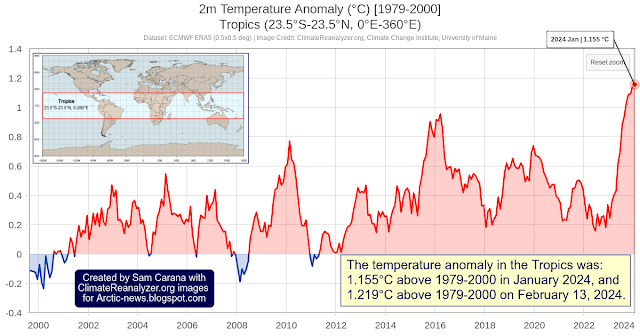Climate change denial and the rise of fascism
by Andrew Glikson
but they can be sure that they won't be recorded for their crimes in history -- because
there won't be any history” (Noam Chomsky, 2023, in a letter to the author)
Extreme planetary heating, the failure of effective mitigation and the rise of denial around the world combine to lead to a seventh
mass extinction of species. While originally Global warming constituted an unintended consequence of the 18-20ᵗʰ centuries industrial revolution, the collapse of attempts to arrest it in the 20-21st centuries is already leading toward a
mass extinction, but the rise of fascist movements and their neoconservative kins is jeopardizing a unified global approach to the climate crisis. Inherently however racist ideology, worship of power, glorification of war, the pride of killing and “honourable” death is not concerned with the fatal consequences of climate change.
 |
Figure 1. 2023 was the warmest year since global records began in 1850 by a wide margin. It was 1.18°C
above the 20th-century average of 13.9°C. It was 1.35°C above the pre-industrial average (1850-1900).
|
While the authorities (so-called) claim they are trying to
arrest global warming, temperatures continue to rise to fatal levels (Figure 1). Ignoring climate science, dismissing climate scientists and confecting lies while global
heating accelerates with deleterious consequences, the species sapiens is finding itself on track to carbon saturation to Miocene levels (420< ppm) of its atmosphere ─ the lungs of the Earth ─ at a
geologically unprecedented rate. The extreme rise in the chemistry of the atmosphere, the acidification of the oceans and the coating of the land with carbon residues and plastics are leading toward an
uninhabitable Earth.
With exceptions governments pretend the introduction of alternative energy ─ solar, wind, hydrothermal, hydro and tide ─ is likely to reduce the mining of and emission from fossil fuels, but this has
hardly occurred since 2022. Oblivious to the implications of climate science, the concerns of the powers that be hinge on the bottom line, an attitude
echoed by much in the population. False claims abound in high places, as exemplified by the chair of COP-28 conference claiming: “there is ‘
no science’ behind demands for phase-out of fossil fuels”.
Everywhere, including Australia, carbon counting hinges on domestic mining and emissions to the exclusion of carbon exports. Thus “
Oil, gas, and coal exports are not counted when countries tally their greenhouse gas emissions under the Paris Agreement.”
Hopeful popular belief abound, as if new science-based discoveries could resolve climate change, as by the optimistic projection by
NASA: “While we cannot stop global warming overnight, we can slow the rate and limit the amount of global warming by reducing human emissions of heat-trapping gases and soot.
Such suggestions overlook the amplifying feedback from warming oceans, melting ice sheets. disintegrating permafrost, release of methane from the oceans, and migrating climate zones. Scientists are caught between a need to promote mitigation and adaptation on the one hand and a reluctance to communicate the impending calamity.
Australia’s enshrined emissions cut target of 43% by 2030, up from 26-28%, has limited consequences since it has become the fifth largest miner and the
world’s third biggest exporter of fossil fuels, exporting only behind Russia and Saudi Arabia, more than Iraq, Venezuela and any country in the EU.
The blood-stained history of Homo sapiens since the mastery of fire (Figure 2), all the way to the
Anthropocene crisis, combined with the proliferation of doomsday weapons, do not bode well for the future of terrestrial species.
Global empires east and west have become increasingly brutal. Fascism ─ the ideology of death ─ and its neo-conservative (so-called) followers are not concerned with global warming and its consequences, except where it hurts the profit motive. References to “climate change” by politicians constitute hollow words they hardly mean. There are not too many angels left except where the young like
Greta Thunberg rebel.
 |
| Figure 2. The deep time origin of the Anthropocene. |
A/Prof. Andrew Y Glikson
Earth and Paleo-climate scientist
































